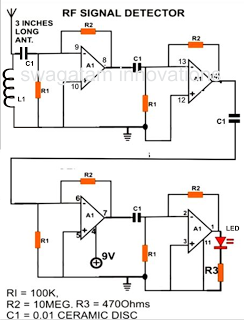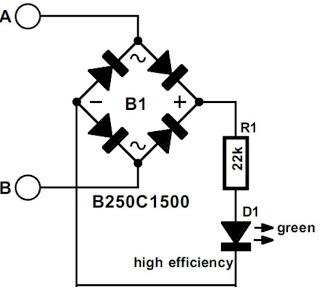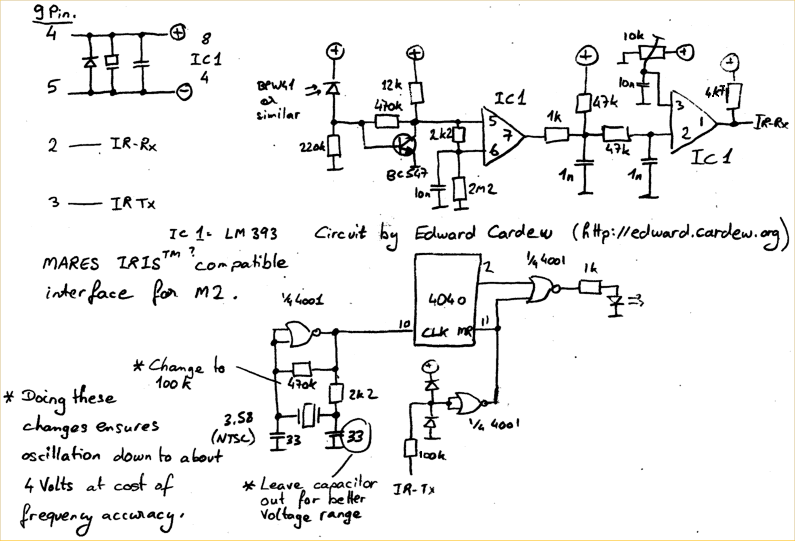
How to Make a Cell Phone RF Signal Detector Circuit

A simple electronic circuit project is presented that can be constructed by any school student for display at a school science fair. The proposed circuit is a high-gain operational amplifier (op-amp) amplifier designed to detect the slightest RF disturbances generated by various electrical systems, with cell phones being a major source of RF interference. This circuit easily picks up such interference, which can be observed through LED illumination at the output. The circuit is fundamentally a high-gain non-inverting AC amplifier built around the IC LM324. Although only two of its op-amps may be utilized, to enhance sensitivity, all four op-amps have been configured in series. The op-amp is set up as a high-gain non-inverting amplifier, where the input is received at pin #2, the inverting input of the op-amp. RF disturbances in the environment are captured by the antenna and fed to the non-inverting input of the op-amp, where they are amplified to a specified level based on the value of the feedback resistor connected between the output and the non-inverting input of the op-amp. Increasing the feedback resistor value raises the circuit's sensitivity; however, excessive sensitivity can lead to instability and oscillations. The relatively weaker signals from the first stage are further enhanced and strengthened before being sent to the third stage for additional amplification until the final stage, where the output illuminates an LED, indicating the presence of even the smallest RF disturbances in the air. This cell phone RF signal detector circuit is straightforward to build and requires minimal electronic knowledge. The construction follows these instructions: Begin connecting the resistors and capacitors to the IC pinouts according to the provided diagram, noting that the pinout will appear reversed from the component side of the PCB compared to the track side. To test the circuit, a call can be made from a cell phone or a balance inquiry can be performed; the LED in the circuit should respond to the RF signals emitted by the cell phone. Alternatively, clicking a kitchen gas lighter near the antenna should cause the LED to flash in response to the RF signals generated. Another testing method involves bringing the circuit close to an electrical mains board, where the LED should illuminate when positioned within a foot of the board, indicating the presence of the mains field and confirming the circuit's functionality.
The circuit utilizes the LM324 IC, which contains four op-amps that can be configured for various applications. In this particular setup, the op-amps are arranged in a cascading configuration to maximize the amplification of RF signals. The use of a non-inverting configuration allows for a straightforward gain calculation, defined by the formula \( G = 1 + \frac{R_f}{R_{in}} \), where \( R_f \) is the feedback resistor and \( R_{in} \) is the input resistor. This design choice ensures that the circuit can amplify weak RF signals without inverting their phase, which is critical for accurate signal detection.
The antenna plays a pivotal role in capturing RF disturbances. It is recommended to use a simple wire antenna, which can be easily constructed by cutting a length of wire to an appropriate size based on the frequency range of interest. The antenna should be connected to the non-inverting input of the first op-amp, allowing it to receive RF signals from the surrounding environment.
For stability, it is essential to carefully select the feedback resistor values. While increasing resistance enhances sensitivity, it is crucial to avoid values that could lead to oscillation. Capacitors may also be added in parallel with the feedback resistor to introduce a low-pass filter effect, which can help stabilize the circuit by filtering out high-frequency noise that may cause false triggering of the LED.
The output stage of the circuit is connected to an LED, which serves as a visual indicator of RF signal presence. The LED should be connected in a way that allows it to be illuminated by the amplified output signal from the last op-amp stage. A current-limiting resistor is necessary to protect the LED from excessive current.
Overall, this RF signal detector circuit is an excellent educational project for students, providing hands-on experience with op-amp configurations, signal amplification, and RF detection principles. Its simplicity and effectiveness make it a valuable tool for understanding electronic circuit design and the behavior of RF signals in the environment.A simple electronic circuit project is discussed here that may be built by any school student for displaying in a school fair science exhibition. The proposed circuit is a high gain opamp amplifier which detects slightest of RF disturbance that might be created by various electrical systems.
Cell phone being the major generator of RF interference is easily picked up by this circuit and can be seen through an LED illumination at the output of the circuit. The circuit is basically a simple high gain non inverting AC amplifier, built around the IC LM 324. Only two of its op amps may be incorporated, however for making the circuit extremely sensitive, all four of its opamps have been rigged in series.
As mentioned in the earlier part of this article, the opamp is configured as a high gain non inverting amplifier, where the input is received at the pin #2which is the inverting input of the op amp. The RF disturbances in the air is received by the antenna and fed to the non inverting input of the opamp which is simply amplified by the circuit to some specified level depending on the value of the feed back resistor across the output and the non inverting input of the opamp.
Increasing the value of this resistor increases the sensitivity of the circuit, however too much sensitivity can make the circuit unstable and induce oscillations. Here the relatively weaker signals from the first stage is further enhanced and made stronger so that now it may be fed to the third stage for repeating the actions that is for further amplification until the last stage whose output illuminate an LED, displaying the presence of even the minutest possible RF disturbance in the air.
The discussed circuit of cell phone RF signal detector, sensor is very easy to build and requires minimal knowledge of electronic for going about with the procedures. It is built with the following instruction: Now as per the diagram start connecting the resistors and capacitors one by one to the pin outs of the IC, remember that from the component side of the PCB, the pin out will be just the opposite to what it is from the track side, so be careful with the pin out designations and connections.
For this you may make a call from your cell phone or just call to know your balance report, the LED in the circuit should hopefully start responding to the cell phones generated RF signals. Alternatively, you may try clicking your kitchen gas lighter very close to the antenna of the circuit; the LED could be seen flashing with the clickings of the gas lighter.
Another way of checking the circuit would be to take it near your mains electric board, the LED should light up when brought even withing a feet near to the board indicating the presence of the mains field and confirming the working of the circuit. 🔗 External reference
The circuit utilizes the LM324 IC, which contains four op-amps that can be configured for various applications. In this particular setup, the op-amps are arranged in a cascading configuration to maximize the amplification of RF signals. The use of a non-inverting configuration allows for a straightforward gain calculation, defined by the formula \( G = 1 + \frac{R_f}{R_{in}} \), where \( R_f \) is the feedback resistor and \( R_{in} \) is the input resistor. This design choice ensures that the circuit can amplify weak RF signals without inverting their phase, which is critical for accurate signal detection.
The antenna plays a pivotal role in capturing RF disturbances. It is recommended to use a simple wire antenna, which can be easily constructed by cutting a length of wire to an appropriate size based on the frequency range of interest. The antenna should be connected to the non-inverting input of the first op-amp, allowing it to receive RF signals from the surrounding environment.
For stability, it is essential to carefully select the feedback resistor values. While increasing resistance enhances sensitivity, it is crucial to avoid values that could lead to oscillation. Capacitors may also be added in parallel with the feedback resistor to introduce a low-pass filter effect, which can help stabilize the circuit by filtering out high-frequency noise that may cause false triggering of the LED.
The output stage of the circuit is connected to an LED, which serves as a visual indicator of RF signal presence. The LED should be connected in a way that allows it to be illuminated by the amplified output signal from the last op-amp stage. A current-limiting resistor is necessary to protect the LED from excessive current.
Overall, this RF signal detector circuit is an excellent educational project for students, providing hands-on experience with op-amp configurations, signal amplification, and RF detection principles. Its simplicity and effectiveness make it a valuable tool for understanding electronic circuit design and the behavior of RF signals in the environment.A simple electronic circuit project is discussed here that may be built by any school student for displaying in a school fair science exhibition. The proposed circuit is a high gain opamp amplifier which detects slightest of RF disturbance that might be created by various electrical systems.
Cell phone being the major generator of RF interference is easily picked up by this circuit and can be seen through an LED illumination at the output of the circuit. The circuit is basically a simple high gain non inverting AC amplifier, built around the IC LM 324. Only two of its op amps may be incorporated, however for making the circuit extremely sensitive, all four of its opamps have been rigged in series.
As mentioned in the earlier part of this article, the opamp is configured as a high gain non inverting amplifier, where the input is received at the pin #2which is the inverting input of the op amp. The RF disturbances in the air is received by the antenna and fed to the non inverting input of the opamp which is simply amplified by the circuit to some specified level depending on the value of the feed back resistor across the output and the non inverting input of the opamp.
Increasing the value of this resistor increases the sensitivity of the circuit, however too much sensitivity can make the circuit unstable and induce oscillations. Here the relatively weaker signals from the first stage is further enhanced and made stronger so that now it may be fed to the third stage for repeating the actions that is for further amplification until the last stage whose output illuminate an LED, displaying the presence of even the minutest possible RF disturbance in the air.
The discussed circuit of cell phone RF signal detector, sensor is very easy to build and requires minimal knowledge of electronic for going about with the procedures. It is built with the following instruction: Now as per the diagram start connecting the resistors and capacitors one by one to the pin outs of the IC, remember that from the component side of the PCB, the pin out will be just the opposite to what it is from the track side, so be careful with the pin out designations and connections.
For this you may make a call from your cell phone or just call to know your balance report, the LED in the circuit should hopefully start responding to the cell phones generated RF signals. Alternatively, you may try clicking your kitchen gas lighter very close to the antenna of the circuit; the LED could be seen flashing with the clickings of the gas lighter.
Another way of checking the circuit would be to take it near your mains electric board, the LED should light up when brought even withing a feet near to the board indicating the presence of the mains field and confirming the working of the circuit. 🔗 External reference





